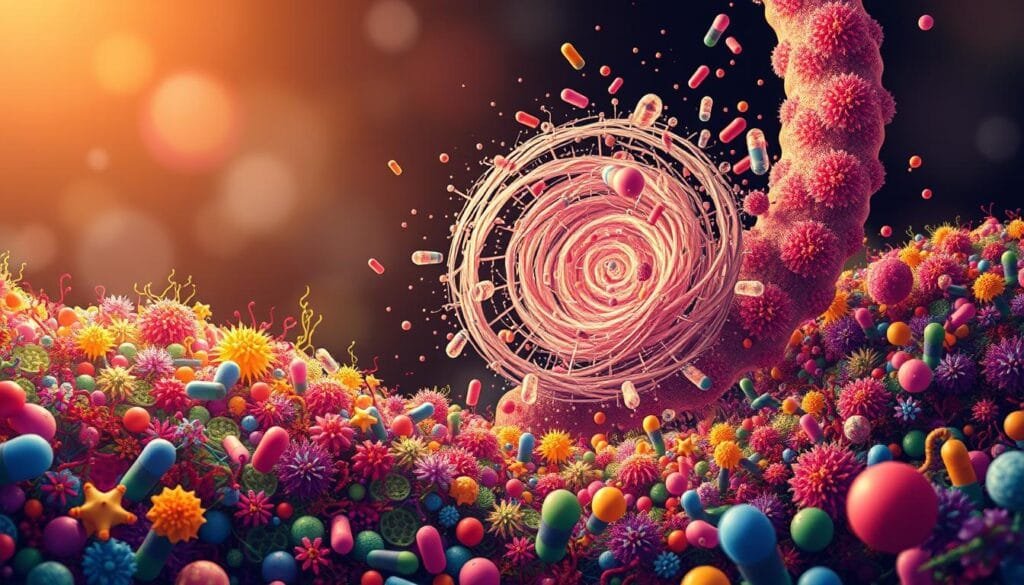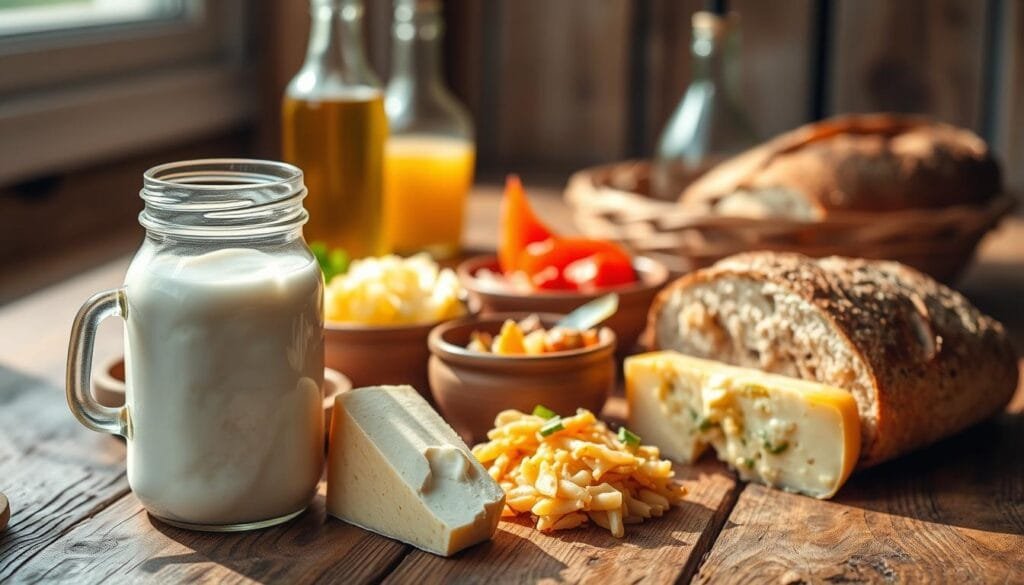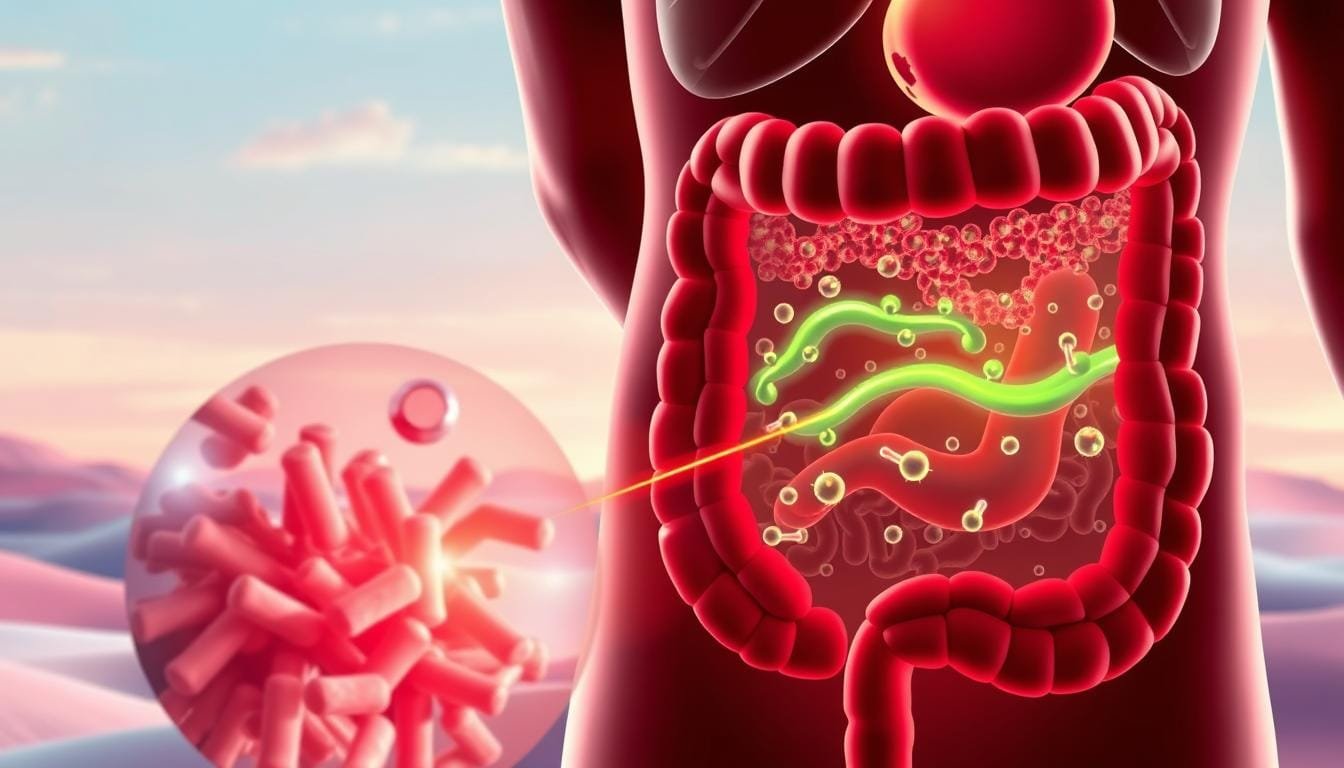Currently Empty: RM0.00
Antibiotics play a vital role in fighting infections, but they often disrupt the delicate balance of microorganisms in the digestive system. This imbalance can lead to uncomfortable side effects like bloating or diarrhea. Protecting gut health during treatment requires intentional strategies to support beneficial microbes.
Simple adjustments, such as timing meals around medication or adding fermented foods, help preserve healthy bacteria. Research shows combining these practices with probiotic supplements may reduce digestive discomfort. The goal is to ensure treatments remain effective while safeguarding long-term gut health.
This guide explores practical, science-backed methods to maintain microbial diversity. From dietary choices to supplement schedules, these approaches empower individuals to protect their digestive wellness without compromising antibiotic efficacy.
Key Takeaways
- Antibiotics can disrupt gut microbes, leading to digestive issues
- Strategic meal timing helps minimize medication side effects
- Fermented foods support microbial diversity during treatment
- Probiotic supplements may reduce antibiotic-related discomfort
- Balancing treatment effectiveness with gut protection is crucial
- Simple dietary changes can maintain digestive system balance
Introduction to Gut Health and Antibiotics
Prescription antibiotics save lives by eliminating dangerous pathogens, but they don’t discriminate between harmful and beneficial microbes. These medications target bacterial infections by stopping reproduction or destroying cell structures. Over 150 antibiotic varieties exist, categorized by their scope of action.
Types and Impacts of Antibiotic Treatments
Broad-spectrum antibiotics attack multiple bacterial strains simultaneously, while narrow-spectrum versions focus on specific species. This difference matters for gut ecosystems. Common side effects like diarrhea or bloating often signal microbial imbalance.
| Antibiotic Type | Target Range | Common Uses | Microbiome Impact |
|---|---|---|---|
| Broad-spectrum | Multiple species | Unknown infections | High disruption |
| Narrow-spectrum | Specific bacteria | Targeted therapies | Moderate disruption |
Essential Functions of Gut Microbes
The gut microbiome contains 100 trillion microorganisms that digest fiber, produce vitamins, and train immune cells. These microbes form a protective barrier against pathogens. Research shows they influence everything from mood regulation to metabolic processes.
When antibiotics disturb this balance, temporary deficiencies in nutrient absorption may occur. Strategic probiotic supplementation helps maintain microbial diversity. Understanding this relationship allows patients to protect digestive wellness during treatment.
Understanding the Impact of Antibiotics on Gut Microbiota
Modern medicine relies heavily on antibiotics to combat infections, yet these powerful tools come with unintended consequences for digestive ecosystems. The delicate interplay between microbial communities often suffers collateral damage during treatment.

How Antibiotics Disrupt Gut Balance
Antibiotics act like broad-spectrum weed killers in the gut garden. While eliminating harmful strains, they also wipe out beneficial species that maintain digestive harmony. This disruption creates temporary voids where opportunistic microbes might flourish.
Broad-spectrum varieties cause the most significant microbiome imbalance, affecting 30-40% more species than targeted treatments. A single course can reduce bacterial diversity by up to 25%, according to clinical observations.
Insights from Recent Research Studies
Recent research reveals surprising recovery patterns. While 70% of users regain baseline gut microbiota within eight weeks, others experience prolonged deficits. A 2023 study showed:
- 5-day antibiotic courses eliminate 10-24 bacterial species
- 63% average diversity recovery after six months
- 20% of participants retained permanent changes
These studies highlight why pre-treatment gut health matters. Individuals with robust initial microbiome diversity typically rebound faster than those with compromised digestive systems.
Understanding this impact helps explain why combining antibiotic therapies with microbial support strategies proves essential for maintaining long-term gut health.
How do you get good bacteria while on antibiotics?
Maintaining a healthy gut during antibiotic therapy involves strategic support for beneficial microbes. Combining probiotic supplements with prebiotic-rich meals creates a powerful defense against digestive disruptions. This dual approach helps offset medication impacts while promoting microbial diversity.
The Importance of Probiotics During Antibiotic Treatment
Research indicates starting probiotics early in treatment reduces diarrhea risk by 42%. Spacing doses 4-6 hours after antibiotics improves survival rates of beneficial strains. Clinical trials show this timing allows more live bacteria to reach the intestines intact.
Incorporating Prebiotic Foods for Enhanced Recovery
Foods like garlic and bananas contain fibers that fuel microbial growth. These prebiotic foods work synergistically with supplements to rebuild gut populations. A 2023 study found participants combining both strategies regained microbiome diversity 30% faster than others.
| Strategy | Function | Examples | Optimal Timing |
|---|---|---|---|
| Probiotics | Introduce live microbes | Yogurt, supplements | 2 hours post-antibiotic |
| Prebiotics | Feed existing bacteria | Onions, asparagus | With meals |
Healthcare providers often recommend continuing these practices for 2-4 weeks after finishing medication. This extended support helps establish resilient bacterial communities better equipped to resist future imbalances.
Integrating Probiotics and Fermented Foods into Your Diet
Combining probiotic supplements with fermented foods creates a powerful strategy for microbial restoration during antibiotic treatments. This dual approach helps maintain digestive balance while supporting natural recovery processes.

Selecting Effective Microbial Support
Quality probiotic supplements should contain multiple bacterial strains. Look for products with Lactobacilli and Bifidobacteria species, which research shows survive best in antibiotic-affected environments. Clinical studies recommend formulas with 10-50 billion CFUs for optimal effectiveness.
| Supplement Feature | Optimal Range | Key Benefits |
|---|---|---|
| Bacterial Strains | 4-10 varieties | Enhanced diversity |
| CFU Count | 10-50 billion | Improved colonization |
| Storage Needs | Refrigerated | Increased viability |
Nutritional Allies for Microbial Recovery
Fermented foods offer natural sources of beneficial bacteria that complement supplements. Traditional options like kimchi and tempeh contain unique strains absent in many commercial products. For maximum benefit:
- Choose refrigerated versions with “live cultures” labels
- Include 2-3 varieties daily
- Pair with fiber-rich meals
Recent findings show people consuming fermented vegetables regain gut diversity 40% faster than those relying solely on supplements. These foods also provide prebiotic fibers that nourish existing microbial communities.
Dietary Strategies to Rebuild Beneficial Gut Bacteria
Nutrition plays a starring role in restoring microbial harmony after antibiotic use. Specific foods act like fertilizer for your internal ecosystem, creating ideal conditions for friendly microbes to thrive.
Fueling Microbial Recovery Through Smart Eating
Fiber-rich choices become powerful allies in gut restoration. These plant compounds bypass human digestion, becoming prime food sources for beneficial bacteria. Studies show increased fiber intake helps repopulate microbial communities 22% faster than standard diets.
Timing matters. While antibiotics remain active, high-fiber meals might reduce medication effectiveness. Most healthcare providers recommend boosting these foods after completing treatment:
- Whole grains like oats and barley release energy slowly
- Leafy greens provide unique prebiotic compounds
- Nuts offer healthy fats alongside microbial fuel
Prebiotic superstars like garlic and bananas contain specialized fibers. These selectively nourish desirable microbes while discouraging harmful strains. A 2024 review found people eating 3+ prebiotic foods daily regained gut balance 35% faster than others.
| Food Category | Key Nutrients | Microbial Benefits |
|---|---|---|
| Cruciferous vegetables | Sulforaphane | Supports detoxification |
| Allium family | Inulin fiber | Boosts Bifidobacteria |
| Legumes | Resistant starch | Enhances diversity |
For comprehensive support, consider how probiotics and prebiotics work together to maintain digestive health. Gradually increasing fiber intake helps avoid discomfort while allowing microbes to adapt.
Wellness Concept’s Expert Advice and Contact Information
Navigating antibiotic treatments while protecting gut health requires personalized strategies. Wellness Concept specializes in creating tailored plans that align with medical needs and personal wellness goals.
Customized Support for Digestive Wellness
Their team combines nutritional science with microbiome research to develop effective recovery plans. Clients receive guidance on timing supplements, selecting prebiotic foods, and maintaining microbial balance during treatment courses.
Accessible Gut Health Expertise
Wellness Concept offers convenient consultations via WhatsApp at +60123822655. Available weekdays 9:30 am-6:30 pm and weekends 10 am-5 pm, they provide real-time support throughout antibiotic use.
Trusted for their evidence-based approach, the team stays updated on the latest microbiome research. This commitment ensures recommendations reflect both traditional wisdom and modern scientific understanding.
For those seeking a balanced way to protect digestive health during medical treatments, Wellness Concept bridges the gap between clinical care and holistic wellness practices.
FAQ
How do antibiotics disrupt gut bacteria balance?
Antibiotics target harmful pathogens but also reduce beneficial bacteria diversity. This imbalance can lead to side effects like diarrhea or digestive discomfort, weakening immune function over time.
Can probiotics counteract antibiotic-related gut issues?
Yes. Studies show probiotics like Lactobacillus or Bifidobacterium strains (found in Culturelle or Renew Life supplements) help replenish good bacteria. Taking them 2–3 hours apart from antibiotics maximizes effectiveness.
What foods boost gut health during antibiotic treatment?
Fermented options like Greek yogurt (Chobani), kefir, sauerkraut, or kimchi introduce live cultures. Prebiotic-rich foods—garlic, onions, bananas—nourish existing microbes, aiding faster recovery.
How long does restoring gut flora after antibiotics take?
Research suggests 2–8 weeks, depending on antibiotic type and diet. Consistent fiber intake, probiotics, and avoiding processed sugars accelerate microbial diversity restoration.
Are specific brands recommended for gut health support?
Wellness Concept advocates trusted supplements like Garden of Life Dr. Formulated Probiotics. Their team provides personalized plans via WhatsApp (+1-555-123-4567) for tailored recovery strategies.
Why does fiber matter post-antibiotics?
Fiber feeds beneficial bacteria, promoting short-chain fatty acid production. Foods like oats, apples, and lentils improve gut lining integrity and reduce inflammation linked to prolonged antibiotic use.


